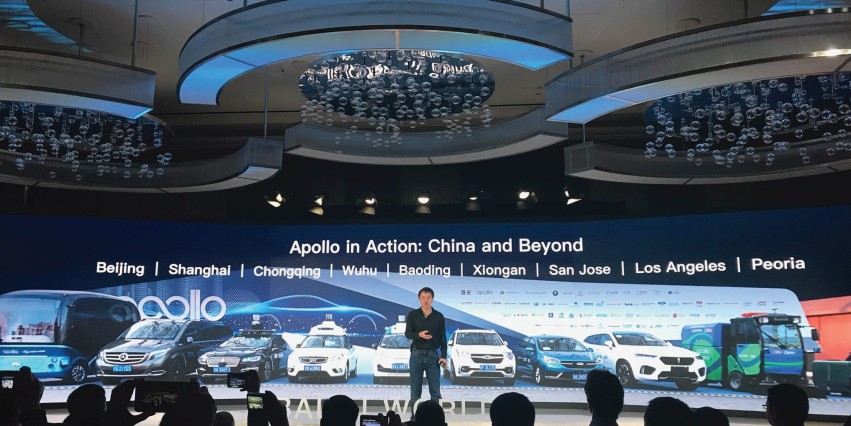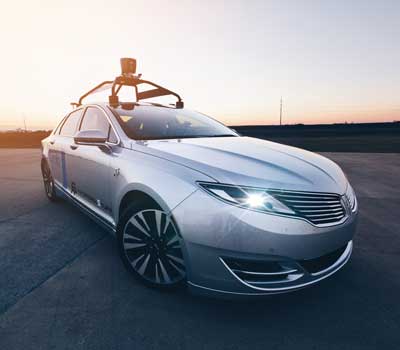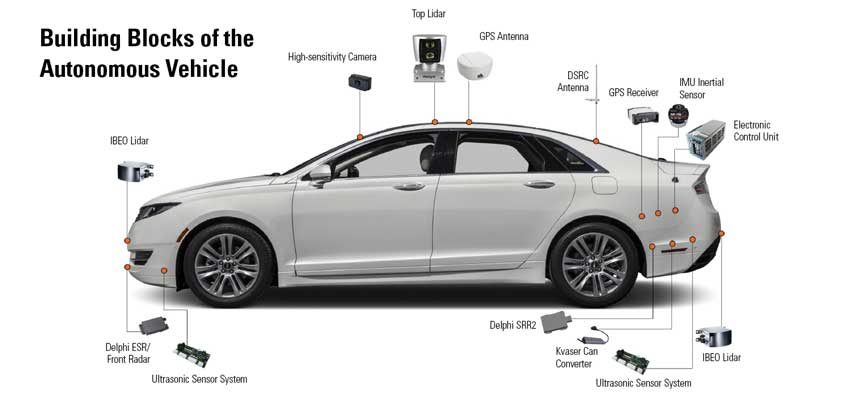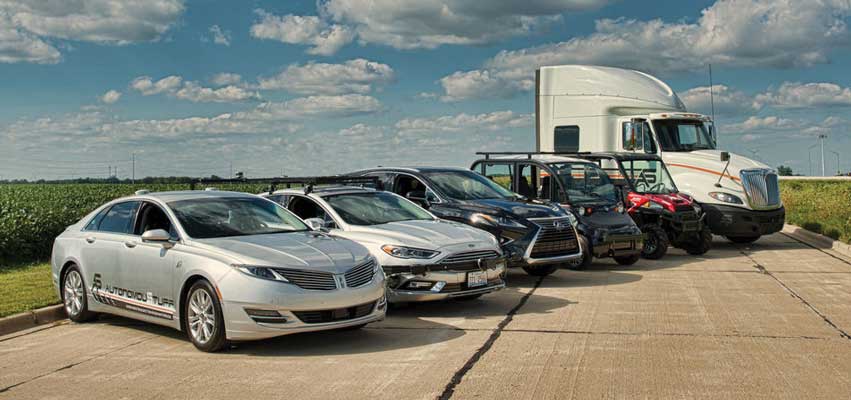With its automated research vehicles and worldwide partnerships, AutonomouStuff has placed Peoria on the global stage for innovation.
Though it may not be a household name in the U.S., Baidu is a tech giant, the world's second-largest search engine and a leader in artificial intelligence research. And just as Google immersed itself in the world of autonomous transportation, Baidu has followed suit.
The Chinese firm’s Apollo project—named for the space program that brought humanity to the moon—has been likened to the “Android of the car industry,” intended to accelerate the development, testing and deployment of autonomous vehicles. As an open-source software platform, anyone can utilize it to develop systems or components for self-driving vehicles. More than 80 partners worldwide have signed onto the effort, from big automakers and Tier 1 suppliers to tech companies, universities and more.
In January, Baidu made a splash at the Consumer Electronics Show (CES) in Las Vegas, unveiling its latest iteration: Apollo 2.0. From the stage, Baidu COO Qu Li touted the latest features of China’s own AI-driven moonshot. Behind him, the wraparound screen showcased a fleet of Apollo-enabled vehicles, partner logos, and the names of nine major cities: Beijing, Shanghai, Chongqing, Wuhu, Baoding, Xiongan, San Jose, Los Angeles… and Peoria. Yes, Peoria.
Just how did Peoria end up here at CES, the global stage for innovation? That achievement came courtesy of AutonomouStuff, which joined forces with Baidu last year to equip its research vehicles with Apollo technologies. Based just outside of Peoria in the Village of Morton, this small but mighty company has more knowledge and experience in automated driving research than anyone else in the world.

Bootstrapping a Global Brand
Tech companies have been in the spotlight lately, and not always for the better. Facebook is in the crossfire for its dissemination of “fake news” and manipulation by foreign influences on the 2016 presidential election. Uber was a poster child for the bad behavior of tech mavens, until it finally fired founder and CEO Travis Kalanick. And while Uber’s recently settled court battle with Waymo (formerly Google’s self-driving car project) ended in a whimper, it highlighted the cutthroat nature of business in Silicon Valley.
Interestingly, the very trade secrets that prompted the suit against Uber—the LiDAR sensor technologies that allow self-driving cars to detect and measure the distance between objects—are quite familiar to AutonomouStuff founder Bobby Hambrick. But confident as he is, Hambrick projects a notable contrast to the brash arrogance of Uber’s Kalanick. He’s not a jerk. He responds to emails. He doesn’t come off as pretentious or full of himself. Perhaps it’s the Midwesterner in him: the hometown kid and East Peoria high school graduate, Class of 1998.
 The AStuff story is practically a fairy tale. Hambrick started the company in his bedroom, handling everything from the website to shipping/receiving to sales to technical support. Since 2010, he’s built AutonomouStuff into the leading global supplier of products related to autonomous driving. “We have been profitable every single month since we started,” he states matter-of-factly. “And we’re totally bootstrapped—there's no outside investment. In this industry, we are the only company like this.”
The AStuff story is practically a fairy tale. Hambrick started the company in his bedroom, handling everything from the website to shipping/receiving to sales to technical support. Since 2010, he’s built AutonomouStuff into the leading global supplier of products related to autonomous driving. “We have been profitable every single month since we started,” he states matter-of-factly. “And we’re totally bootstrapped—there's no outside investment. In this industry, we are the only company like this.”
Three years ago when iBi first profiled the company, self-driving cars still felt like a sci-fi concept from a far-off future. In 2015, most of Hambrick’s clients were industrial and military customers. But as the automotive industry has plunged into the field, AStuff is right in the thick of it. Its mission has never wavered: to enable the future of autonomy. But while pursuing that lofty goal, many changes have taken place at AutonomouStuff. In addition to the Baidu partnership, among others, they include:
- The creation and expansion of an Automated Research Development Platform fleet;
- The addition of team members with expertise in vehicle integration and software engineering;
- A new focus on data intelligence products and services;
- Multiple expansions of its Morton, Illinois headquarters;
- The opening of offices in Detroit, San Jose and Beijing, China; and
- The launch of AutonomouStuff GmbH, a wholly owned German subsidiary.
Month after month, AStuff newsletters tell the tale of growth and expansion—of new products, new services and new partners. The company nearly tripled in size in 2016, and more than doubled in 2017.
Their new office in San Jose placed them right in the heart of Silicon Valley, where much of the action around automated driving is taking place. That, in turn, led to the Baidu partnership, which is still less than a year old.
Last summer, AutonomouStuff engineers used Baidu’s Apollo platform to create prototype vehicles for demonstration. Just six months later, they upgraded those vehicles to Apollo 2.0 in less than a week—an update that allows them to stop based on objects in front of them, follow at a set distance, detect stoplights, recognize other vehicles and pedestrians, negotiate intersections, and operate both day and night. In December, a film crew hired by Baidu was right here in Morton, filming AStuff’s demo cars for a video that was unveiled at CES.
In 2018, AutonomouStuff is a globally recognized brand. No other company has provided more products and technologies to the autonomous driving industry. That this company remains headquartered in central Illinois is a remarkable story on its own.
Supercomputers on Wheels
“The launch of our automated driving research platforms has put us in the hands of almost everyone in the world doing automated driving research,” Hambrick proudly declares. “We're building between 20 and 30 of them a month for customers worldwide.” These customers range from two-person startups to the world’s largest companies—basically, anyone who needs to understand automated driving starts here.
The initiative has helped transform AutonomouStuff into far more than an online shop for self-driving components. Today at its Morton headquarters, AStuff engineers are integrating these components into the vehicles themselves—and synchronizing all of the data they generate into a single accessible point. “It's like a smartphone on wheels,” Hambrick notes, leading a tour of the warehouse where these vehicles are assembled.
“We give our customers access to the by-wire controls of the vehicle: to control steering, to control braking, to control acceleration, to control shifting, to control blinkers and headlights and the horn,” he explains. “And then they get access to information from the car—like the wheels and decoders, the internal GPS and all of the sensors. On top of that, we add convenience features like power distribution and monitors in the headrest. Then… we help architect the computing architecture, depending on what the customer is trying to do.”
These research vehicles are revolutionizing the industry, Hambrick adds. “What used to take a decade—getting access to everything, [writing] software, building a research car, and getting to a point where you're following waypoints—now we can do that, literally, on Day One.”
At AutonomouStuff.com, anyone can put together their own research vehicles in minutes—it’s like buying a computer from HP or Lenovo. Simply select the type of vehicle (choose from a range of cars, NEVs, off-road vehicles, Class 8 semis or go custom); build type (showroom or R&D); components (use a pre-built starter kit or build your own); GPS navigation kits; software (developed by AStuff or one of its partners); and data storage (kit or custom).

Each is unique—“we rarely make more than one of the same,” Hambrick notes. Custom racks on the front of the car allow flexibility for the positioning of sensors and cameras, with similar options for lidar and radar on the roof. “And you don’t even want to look in the trunk,” he jokes. “There’s like 50 computers in [there].
“That sensor spinning on top creates 1.2 million points per second of data,” Hambrick says, gesturing at the rooftop laser scanner. And that’s just from a single component. With dozens of high-definition cameras and sensors continuously producing reams of ones and zeros, the result is a new avenue for company growth: data intelligence and storage.
“We help architect how to handle the data these vehicles create,” Hambrick explains. “In some cases, it's terabytes of data an hour—which is massive.” Not only must the vehicle process this data into instructions for moving safely through the world, it must communicate with other cars and smart infrastructure (such as traffic lights and parking meters), as well as relaying the data to the cloud for further analysis.
“Infrastructure data storage,” he adds, “is becoming another core of our business.” And it’s only the beginning of an entirely new digital platform that will eventually extend anywhere cars can travel.
A High-Stakes Competition
There's a race in the industry right now, a high sense of urgency. “The entire automotive market—which trickles down to many, many other markets—is totally being redefined,” Hambrick explains. The traditional market was about selling a car, but “the future of the automotive industry is going to be much more commoditized. The car itself is not going to be the value anymore. The value is in the experience of being in a car, or the service of getting from point A to point B.”
It’s the emerging alternative to ownership: fleets of self-driving cars that pick you up and take you where you need to go, on demand. Add the notion of sponsored rides, and transportation could even become free, so long as riders are willing to watch an ad—or be steered toward the sponsor along the way.
“The value is the interaction with the vehicle, and the data you trade with the vehicle,” Hambrick notes. “That's why GM and Ford and Volvo and Uber and Lyft and all these other companies are planning fleets of shared economy-type cars, which they'll do autonomously or semi-autonomously—especially in areas of high-density populations. That has shifted the whole business… this is why Ford has a new CEO. This is why GM acquired a 40-person startup for a billion dollars. The whole industry is transforming.”
With new innovation centers in Silicon Valley, the big automakers are investing billions in research and development, in partnerships, in acquisitions. “Some of them have a strategy. Some don't really know what the end strategy is—they just know they need to go this direction,” Hambrick says. General Motors is pursuing vertical integration, having recently snatched up the autonomous-vehicle startup Cruise Automation, as well as its own LiDAR manufacturer, Strobe. It plans to launch a self-driving Chevrolet Bolt next year—the “first without a steering wheel or pedal.” Ford invested $1 billion in Argo AI last year, announcing plans for its own self-driving car by 2021.

AutonomouStuff’s fleet of automated driving research vehicles is revolutionizing the industry.
Self-driving Ubers are already rolling through the streets of Pittsburgh. Waymo expects to launch a self-driving taxi service in the Phoenix suburbs this year, while Tesla will demo its Autopilot feature on a coast-to-coast trip from California to New York. A brand-new startup, Aurora Innovation, poached leaders from all three companies—and has already confirmed partnerships with Volkswagen and Hyundai.
After acquiring several startups of its own, Delphi, traditionally an automotive parts business, split into two companies: Delphi Technologies and Aptiv. The latter will focus on “new mobility solutions, smart vehicle architecture and connected cars to connected cities.” And the list goes on: automotive companies becoming tech companies, tech companies entering the automotive market, and mobility as the buzzword of the day.
“Intel bought Mobileye for $15 billion—so even the silicon manufacturing business is rapidly changing,” Hambrick adds. “They see automated driving as a big data play—a big processing play. So it's disrupting a lot of industries.”
The Future, Inevitable
The arrival of self-driving cars promises better commutes, fewer accidents, more leisure time, less pollution, greater efficiencies and massive leaps in AI technologies. A recent industry report suggests the new “passenger economy” enabled by autonomous driving technologies will be worth $7 trillion by 2050.
But of course, steep hurdles remain. Americans are still wary of driverless cars—67 percent, according to one recent survey. There are technological challenges: improving the reliability and durability of hardware components; lowering the costs of LiDAR; decreasing power requirements; improving software to reach acceptable thresholds of safety.
There are regulatory concerns: research commissioned by the National Highway Traffic Safety Administration in 2016 found that nearly half of current federal auto regulations may pose significant roadblocks to the deployment of automated vehicles. And then are the larger societal implications: the potential collapse of entire industries, job losses in the tens of millions—although some suggest the doom and gloom is overstated, that self-driving cars will merely complement the unique abilities of humans, not just replace them.
The nice thing for Bobby Hambrick is, he doesn’t really have to worry about these matters. “That's mostly because we're not working at a mass deployment level,” he explains. “We’re paying attention, but I'm not spending a lot of my resources on it. I'm trying to scale the company.”
As for its competition, AutonomouStuff is a rare breed. “There are other companies that do automated driving software. There are companies that sell products for some pieces of automated driving. There are even a few companies that do some integration stuff,” Hambrick says. “But all of them do these things individually. No one pulls everything together.” So long as it maintains this unique position, AutonomouStuff will succeed—no matter who wins the autonomous-driving race.

At its Morton headquarters, AStuff engineers are assembling 20 to 30 automated research vehicles every month… and no two are alike.
Scaling Upward
From its humble origins to its partnerships with industry titans, AutonomouStuff has come a long way—an unlikely story that is not lost on Hambrick. “I mean, these guys are basically in the middle of nowhere, and they're enabling the entire global industry,” he muses in third-person. “This company is totally bootstrapped, with a single owner, and somehow in the middle of every automated driving initiative. That's crazy, right?”
These days, Hambrick splits his time between the Midwest and AStuff’s expanding footprint around the world—globetrotting to Silicon Valley and Detroit, to China and Japan, to Germany and beyond—all while ensuring his company is running smoothly and primed for continued growth. Why stay in central Illinois? He cites the low cost of living, quality of life (a.k.a. no traffic) and the region’s loyal, hardworking people. “There's a lot of good operations people around here—a lot of good integration guys. That's become very valuable to have.”
On the other hand, there’s a severe lack of capital and a shortage of robotics experts and software engineers—especially those with automotive or autonomous driving experience. “But that's why we have an office in Silicon Valley,” he notes. “So I'm very limited on some resources, but not on others. There are definitely restrictions, but I make it work.”
Hambrick takes great pride in the team he’s built here. “We're doing amazing things. We have an awesome team that is very dedicated,” he states. “I've only lost three people since I started the company… and in this industry, that's unheard of.” Now his charge is to maintain the idealistic workplace he’s worked hard to cultivate, while taking the company to new heights. “I want the culture here to be unique, inspiring and motivating. I want people to feel appreciated and passionate about what they're doing. I want them to be led in a way that makes them better.
“I've been told many times that you lose that as you scale—but it’s my mission not to,” he adds. “So as we’re growing, that's going to be more and more of a focus for my teams: how we can maintain this amazing work environment.” As the industry tears ahead at breakneck speed, AutonomouStuff grows with it. The company is approaching 3,000 customers worldwide, and the year ahead promises further expansion in Europe, the United States and Asia. Here in central Illinois, Hambrick recognizes support from many quarters, and hopes to see “how our ecosystem can expand into new opportunities for Peoria.”
“There’s a big industry here,” he says. “There's lots of opportunities; lots of public and private funding that a lot of other universities in the world are capturing.” He hopes the likes of Bradley University, the University of Illinois and other area institutions can capitalize on these openings. “I'm trying to be as supportive as I can. I know they're starting to put together some plans.”
Beyond self-driving cars, Hambrick rattles off a list of industry opportunities—from “road trains” and automated trucking, to campus and corporate shuttles, to flying cars and two-person mobility drones. “I mean anything that moves, right?” he smiles. “As I always say, this is just the beginning.” iBi


